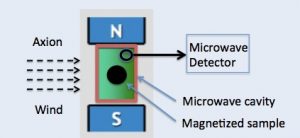Among the most troubling problems for physicists, the nature of dark matter is certainly at the top of the list.
It’s a matter of numbers: this elusive matter contributes for about a quarter to the total energy of the universe, a huge figure considering only a thin 5% comes from ordinary matter and radiation.
What about the rest? It’s dark energy: something which is accelerating the universe’s expansion and which, probably, represents the most relevant issue.
Back to dark matter. The great majority of physicists believes it to be made up of a new kind of particles, not included in Standard Model, and so far gone unnoticed in experimental detection. One in particular has captured the physicists’ attention: the axion. This particle, initially theorized by Peccei and Quinn to explain the absence of CP symmetry violation in strong interactions; it is supposed to be very light, weakly interacting with ordinary matter and radiation. These characteristics make the axion the ideal candidate for dark matter and, above all, would justify their great production in the initial steps of the universe, which would hence appear to be permeated by a sort of “axionic” fluid. Unfortunately, as stated above, all efforts to highlight unequivocally the existence of this fluid failed and, at the moment, the existence of axions is just a working hypothesis.
Yet, considering what’s at stake, no one intends on throwing the towel, and as such, new and more refined and technologically evolved experiments are proposed. The most recent among these, is the QUAX [1] experiment. The pivotal idea for this experiment is completely new and entails the study of the interactions between cosmologic axions and the spin of the electrons of a material plunged into a static magnetic field. Its value was chosen to make sure the Larmor precession (the precession of the electronic spin compared to the direction of the magnetic field) is tuned in the interval of the mass of the axion meant to be investigated (about 100 μeV). This interaction produces a modulation in the magnetization of the material, which generates photon emissions at a radio waves frequency band. The power associated to that modulation is extremely low, hence calling for the building of a detector able to detect single photons, a big technologic challenge.
As means to optimize detection, the material is put inside a microwaves cavity, which is cooled down to a temperature quite close the absolute zero (at about -273 centigrade) in order to reduce the noise associated to thermic photons.
The experiment is currently in its research and development phase at the INFN National Laboratory of Legnaro, meant to go on measure towards the end of 2019. In conclusion, the axion hunt is not over, it goes on with new, and more technologically advanced, weapons. (Danilo Babusci)
[1] R. Barbieri et al., Searching for galactic axions through magnetized media: the QUAX proposal arxiv.org/abs/1606.02201
 INFN-LNF Laboratori Nazionali di Frascati
INFN-LNF Laboratori Nazionali di Frascati
